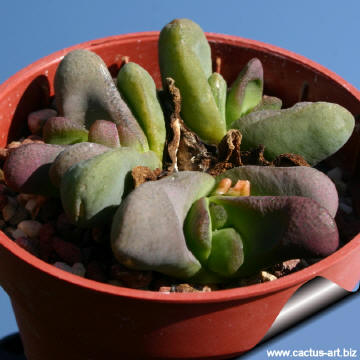|
|
|

Glottiphytllum pygmaeum
It produces
wonderful small growing green or purple tongue-like round leaves.
The flowers are a very cheerful yellow daisy flower.
|
|
Description: The G. pygmaeum is
dwarf form of G. nelii, often confused with G.
neilii. It is a compact, rambling succulent with up to 5
branches (or more with age). It is dormant in high summer heat, and
dormant in the darkness of a cold winter, but otherwise happy to grow
whenever it is watered. The dimension varies from 15 cm tall and 30 cm
in diameter in the standard form to only a few cm in diameter and height
in the “pygmaeus” form (but often
more in cultivation).
Given insufficient light and too much water, they grow into great
sprawling masses of fat, bright green leaves. Given a very bright
position, the leaves are dark green, almost black at times, with red and
purple. There are indeed marked
differences in sizes of leaf and flowers in plants from different
population and also the growing condition (especially sun exposure and
water availability) determine conspicuous differences in habit of
cultivate specimens.
Stem: Almost stem less or very
short stemmed.
Leaves: The plant
produces several, distichous leaves in
2 to 4 (or more) ranks
on each branch.
They are soft, dark green, glossy to
waxy grey. Leaves
have rounded, rarely sharp, edges dotted with dark rounded idioblast.
They are succulent and very juicy in
texture, reminiscent of gummy bears, in full sun they assume a purplish
colouring
Fruit: Persisting in the center of the plant.
Flowers: Long-lived, yellow,
daisy-like and very showy.
Blooming season (Europe):
Late summer-autumn.
|
 |
 |
|
. |
 |
 |
|
Advertising
|
|
|
|
|
|
|
Family: Mesebrianthemaceae (Aizoaceae)
Glottiphyllum pygmaeum
L. Bolus 1933
Accepted
scientific name: Glottiphyllum
nelii Schwantes 1928
Origin:
South Africa (Little Karoo: Oudtshoorn)
Habitat:
They grow in rocks under bushes
or in open. The soisl incorporate slate, sandstone and (mostly) quartz.
Rainfall in their native areas is between 100 and 200 mm, especially in
March and November. Some plant in habitat have
scars or burst in their skins, just like they do at home.
Conservation status: Listed in
CITES appendix 2.
Common Names include: Tounge-Leaf
Etymology: Thegenus name is
from the ancient
Greek
"γλωττίς" (glottis)
, Tongue, and
"φύλλον" (Phyllon),
leaf, The name implies "shaped as a tongue" .
The species name name
"pygmaea"
derives from the Latin name “pygmaeus”
which means “dwarf” and refers to the very
deminute dimension of this plant. ( The specific name implies:
"very dwarf").
Synonyms:
- Glottiphyllum
pallens L. Bolus 1933
|
|
|

Cultivation: The plants in this genus represent some of the more
easily cultivated succulent species. Their main growth period is in late
winter and were heading for spring-summer dormancy, but they do best
with at least a little water all year. Requires little water otherwise
their epidermis breaks (resulting in unsightly scars). Water moderately
from the middle of summer to the end of winter, and keep the compost
almost dry when the plants are dormant. Water minimally in spring and
summer, only when the plant starts shrivelling (, but they will
generally grow even in summer if given water) In areas prone to frost,
grow in an intermediate greenhouse or conservatory, in pots of cactus
compost, obtainable from good garden centres. Keep cool and shaded in
summer, but provide maximum light the rest of the year. However there
are two ways to grow glottiphyllums: The first is to let nature take her
course, which means giving them large pots and copious water; they will
burgeon into enormous masses of glistening green leaves. The other is to
starve them into svelteness by hot summer droughts, small pots, and firm
loam. The results can be very attractive. In any case it is best to
treat them as late winter growers. Soft leaves mean easy to damage.
Propagation: Seeds or
cuttings. Seeds can be sown in early to mid-spring and germinated in
heated humid environment. Alternatively, use stem cuttings taken towards
the end of summer in an heated propagating case (15-21°C)
Note: The 50 or so species of
this South African genus of succulents are so similar that many may be
hybrids.

 |
|